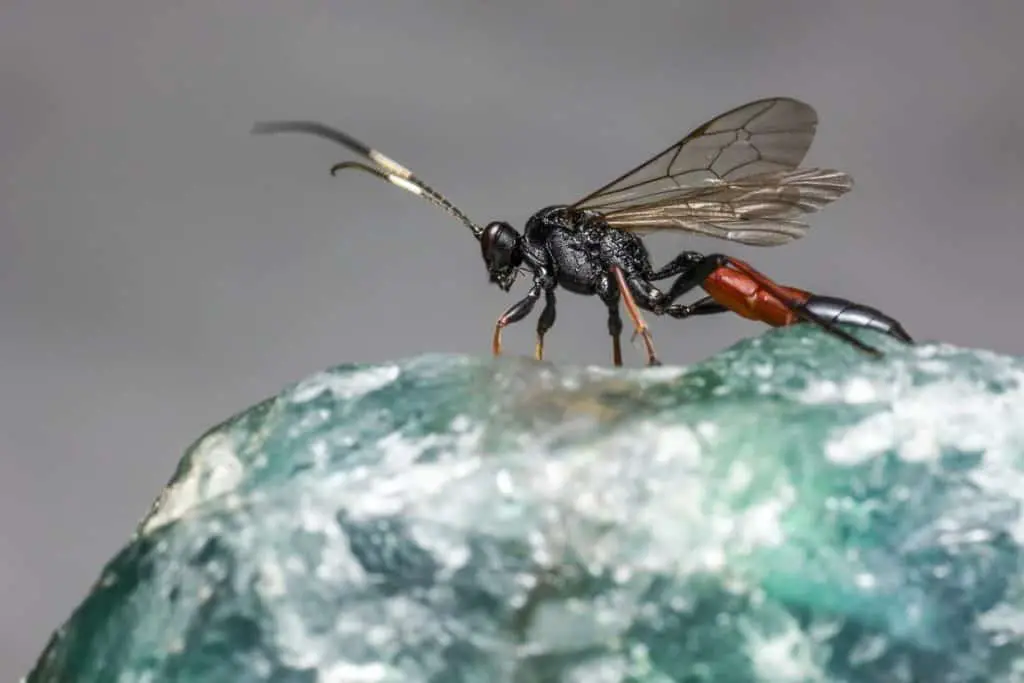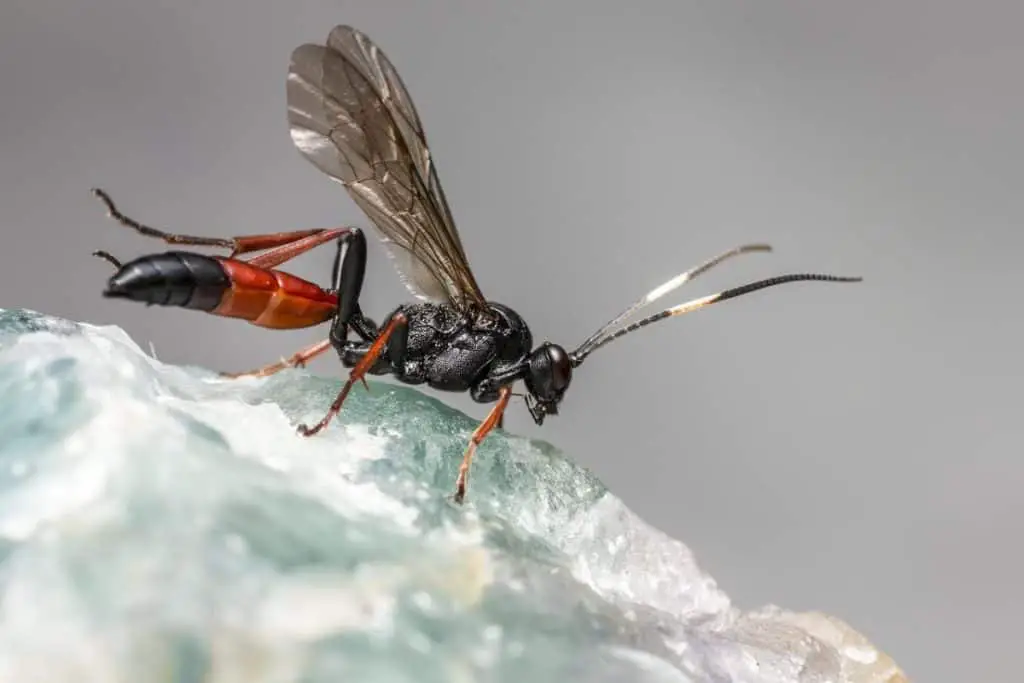Walking through the fields yesterday, I noticed lots of wasps. However, these weren’t just any types of wasps, these were ichneumon wasps, also known as Darwin wasps.
Ichneumon wasps are parasitic wasps that lay their eggs inside or on the skin of other insects. They are parasitoids as the host only lives until the end of the wasp’s larval stage.
There are many parasites throughout the natural world, even in some smaller insects like wasps. Parasitic ichneumon wasps are the deadly enemies of other insects. There are over 24,000 species of Ichneumonidae, also known as ichneumon wasps or Darwin wasps, or ichneumonids.
Are wasps social or solitary insects? The answer may surprise you.

Are They Parasites?
When in the larval stage of their lives, they feed inside the living bodies of caterpillars and other larvae. Ichneumon wasps are four-winged insects, similar to bees and other wasps. However, they differ from them in that almost all their larvae live and feed in the bodies of butterflies, moths, and other insect larvae and pupae. Some have been known to specialize in victimizing spiders.
Parasites need their host to remain alive as long as possible, if it dies, the parasite will also die. This means it is not too accurate to call them parasites. The case of ichneumons is different. The parasitic relationship lasts only as long as the larval life of the ichneumon. At the end of the larval life, the host is killed.
Thus, the host caterpillar will die as soon as the female ichneumon implants her eggs inside it. For this reason, ichneumons and other insects with this particular mode of life are called parasitoids.
Larval stage
If you go somewhere you can find caterpillars and newly-formed chrysalids of the large white and small white butterflies, you might see a dead caterpillar surrounded by little grubs or oval yellow cocoons. These are the early stages of a small ichneumon wasp, Apanteles glomeratus.
This tiny black wasp lays 30-100 eggs under the skin of a half-grown large or small white butterfly caterpillar. When the larvae hatch, they live and grow in their victim’s body, feeding on the blood and fat.
They avoid all the vital organs until the caterpillar prepares to pupate a couple of weeks later. Then the ichneumons devour the whole of the caterpillar’s interior, killing it in the process. The fully fed ichneumon larvae finally emerge through the caterpillar’s skin and spin their cocoons around the withered remains.
You may see adult ichneumons flying around in summer, searching for host victims. Once the female’s eggs have hatched, the parasitized caterpillar, which is being eaten from within, appears smaller than other caterpillars. They also come across as dazed or tired, preferring to sit on a leaf than hiding like other butterflies.
I knew someone who collected butterflies and moths who took home some caterpillars in the hope of rearing specimens, only to find his house full of ichneumon wasps a few days later.
Ichneumons of the Ophion genus are very common, especially the yellow ophion (Ophion luteus). These yellowish-brown insects fly at night and can be seen near artificial light, appearing in houses in the summer. They are parasites of the larvae of larger moths such as the sycamore moth, puss moth, and broom moth.
The female ophion implants a single egg in her chosen victim. Most ichneumon wasp females have long egg-laying organs (ovipositors), but ophions are unusual in having short ones. Another ichneumon, Pimpla instigator, a large species, has a short, spikelike ovipositor and is one of the species which assists in keeping the population of cabbage white butterflies in check.

Egg-laying
A large ichneumon wasp, Rhyssa persuasoria, can be found in pine woods and plantations, searching for the host of its parasitic larva, the giant wood wasp or horntail. The larva of the giant wood wasp bores into the trunk of pine trees or felled timber stacked in the open.
You can see the female Rhyssa—easily identified by her extra-long ovipositor flying about searching pine logs and trunks around June and July. The female drills into the wood with its ovipositor, laying its eggs on larvae living in the timber, which become a food supply and a host, until it is fully grown.
When the female Rhyssa finds the larva she is looking for, she raises her abdomen and bores into the wood with her long, slender ovipositor. The sheaths on either side of the ovipositor do not enter the wood but are raised vertically.
When the tip of the ovipositor reaches the wood wasp larva, an egg is passed down it. The shape of the egg is elongated but regains its oval shape on the skin of the victim. The female then withdraws her ovipositor and flies off searching for another host.
When the egg hatches, the larva remains outside the body of its host throughout its life, sucking blood through the skin. When the Rhyssa larva is fully grown, its host’s body is just a shrunken bag of skin.
How do solitary wasps survive? Find out here.
Benefits Of Ichneumon Wasps
The ichneumon wasp is a useful ally of lumberjacks and foresters because the tunnels made by the wood wasp ruin valuable timber. Parasitoids like Rhyssa are used as agents in the control of insect pests and are particularly effective against pests that have been introduced into territories outside their natural range.
Apanteles glomeratus was the first parasitoid species to be shipped to another continent and be successfully established. Apanteles were exported to the United States from England to help combat the introduced large white butterfly, which was causing serious damage to crops. This species of ichneumon is still one of the most effective enemies of the destructive butterfly.
A wood wasp, Sirex noctilio, is used in pine plantations in New Zealand. In 1928—9, more than 1000 mature Rhyssa larvae were extracted from infested pine trunks in England and sent to New Zealand.
Usually, when an animal is introduced, it can become more numerous and harmful than it is in its native region because its particular natural enemies are likely to be absent. However, ichneumon is more effective than usual because its natural enemies are absent.

